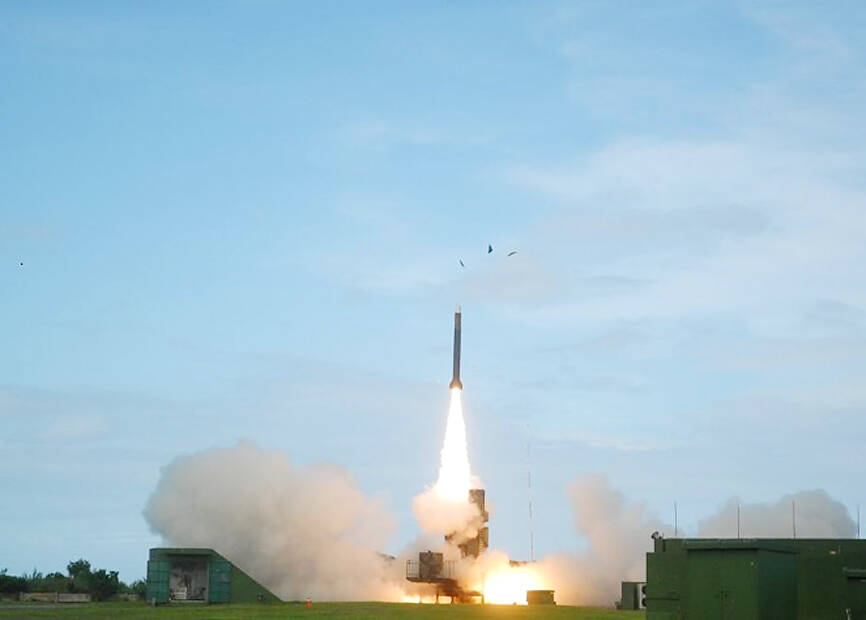The Chungshan Institute of Science and Technology has completed work on a project codenamed “Strong Bow” (強弓), an extended-range version of the Tien Kung III (天弓三, “Sky Bow” III) surface-to-air defense missile, the Ministry of National Defense (MND) said in a report to the legislature.
Testing of the missile’s combat readiness was completed in February, and preparations have begun for mass production and incorporation of the missile into the armed forces’ restructuring plan, the ministry said.
The report to the legislature’s Foreign Affairs and National Defense Committee was written following a request from legislators across party lines for an update on the institute’s progress on developing defensive responses to missile attacks.

Photo courtesy of the Chungshan Institute of Science and Technology
During testing, the missile intercepted objects at altitudes of up to 70km, a source said on condition of anonymity.
A second variant of the Strong Bow, currently in testing, has an estimated intercept altitude of 100km, the person said.
The maximum intercept height of Sky Bow III and Patriot III missiles — both of which are in service in Taiwan — is 40km.
“Although the Strong Bow is referred to as an extended-range Sky Bow III missile, the two are different systems,” the person said.
“The Strong Bow is equipped with a domestically produced, high-efficiency microwave power amplifier, which can intercept intercontinental ballistic missiles and other objects at much greater altitudes than the US-made Patriot missile,” the person said.
The Strong Bow also uses a new type of cone cover, along with a composite material for the fuselage and a more efficient propulsion system, all of which are an improvement on the Sky Bow III’s performance, the source said.
The Chungshan Institute had been testing the Strong Bow at a missile base in Pingtung County’s Jiupengwan Bay (九鵬灣), where it also might be testing a longer-range version of the Hsiung Feng II-E (雄風, “Brave Wind”) missile, under the project name Hsiung Sheng (雄昇), the person said.
Part of those tests included simulated intercepts of a ballistic missile, which was first successfully tested at the site on Aug. 18 last year, the source said.
The ministry said it is bolstering its overall missile defense network to provide it with an improved defensive advantage against enemy threats.

A magnitude 7.0 earthquake struck off Yilan at 11:05pm yesterday, the Central Weather Administration (CWA) said. The epicenter was located at sea, about 32.3km east of Yilan County Hall, at a depth of 72.8km, CWA data showed There were no immediate reports of damage. The intensity of the quake, which gauges the actual effect of a seismic event, measured 4 in Yilan County area on Taiwan’s seven-tier intensity scale, the data showed. It measured 4 in other parts of eastern, northern and central Taiwan as well as Tainan, and 3 in Kaohsiung and Pingtung County, and 2 in Lienchiang and Penghu counties and 1

FOREIGN INTERFERENCE: Beijing would likely intensify public opinion warfare in next year’s local elections to prevent Lai from getting re-elected, the ‘Yomiuri Shimbun’ said Internal documents from a Chinese artificial intelligence (AI) company indicated that China has been using the technology to intervene in foreign elections, including propaganda targeting Taiwan’s local elections next year and presidential elections in 2028, a Japanese newspaper reported yesterday. The Institute of National Security of Vanderbilt University obtained nearly 400 pages of documents from GoLaxy, a company with ties to the Chinese government, and found evidence that it had apparently deployed sophisticated, AI-driven propaganda campaigns in Hong Kong and Taiwan to shape public opinion, the Yomiuri Shimbun reported. GoLaxy provides insights, situation analysis and public opinion-shaping technology by conducting network surveillance

Taiwan is gearing up to celebrate the New Year at events across the country, headlined by the annual countdown and Taipei 101 fireworks display at midnight. Many of the events are to be livesteamed online. See below for lineups and links: Taipei Taipei’s New Year’s Party 2026 is to begin at 7pm and run until 1am, with the theme “Sailing to the Future.” South Korean girl group KARA is headlining the concert at Taipei City Hall Plaza, with additional performances by Amber An (安心亞), Nick Chou (周湯豪), hip-hop trio Nine One One (玖壹壹), Bii (畢書盡), girl group Genblue (幻藍小熊) and more. The festivities are to

AFTERMATH: The Taipei City Government said it received 39 minor incident reports including gas leaks, water leaks and outages, and a damaged traffic signal A magnitude 7.0 earthquake struck off Taiwan’s northeastern coast late on Saturday, producing only two major aftershocks as of yesterday noon, the Central Weather Administration (CWA) said. The limited aftershocks contrast with last year’s major earthquake in Hualien County, as Saturday’s earthquake occurred at a greater depth in a subduction zone. Saturday’s earthquake struck at 11:05pm, with its hypocenter about 32.3km east of Yilan County Hall, at a depth of 72.8km. Shaking was felt in 17 administrative regions north of Tainan and in eastern Taiwan, reaching intensity level 4 on Taiwan’s seven-tier seismic scale, the CWA said. In Hualien, the